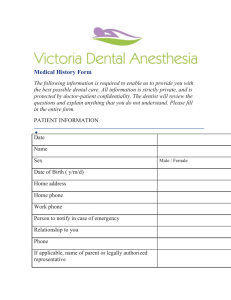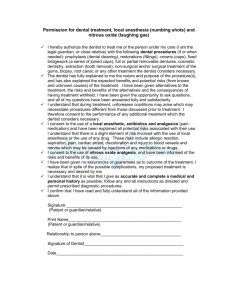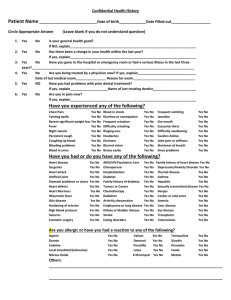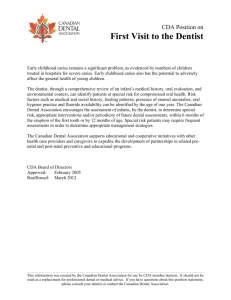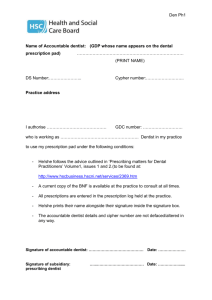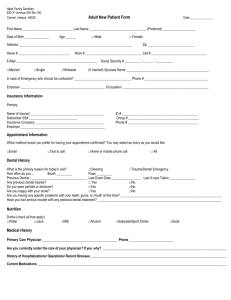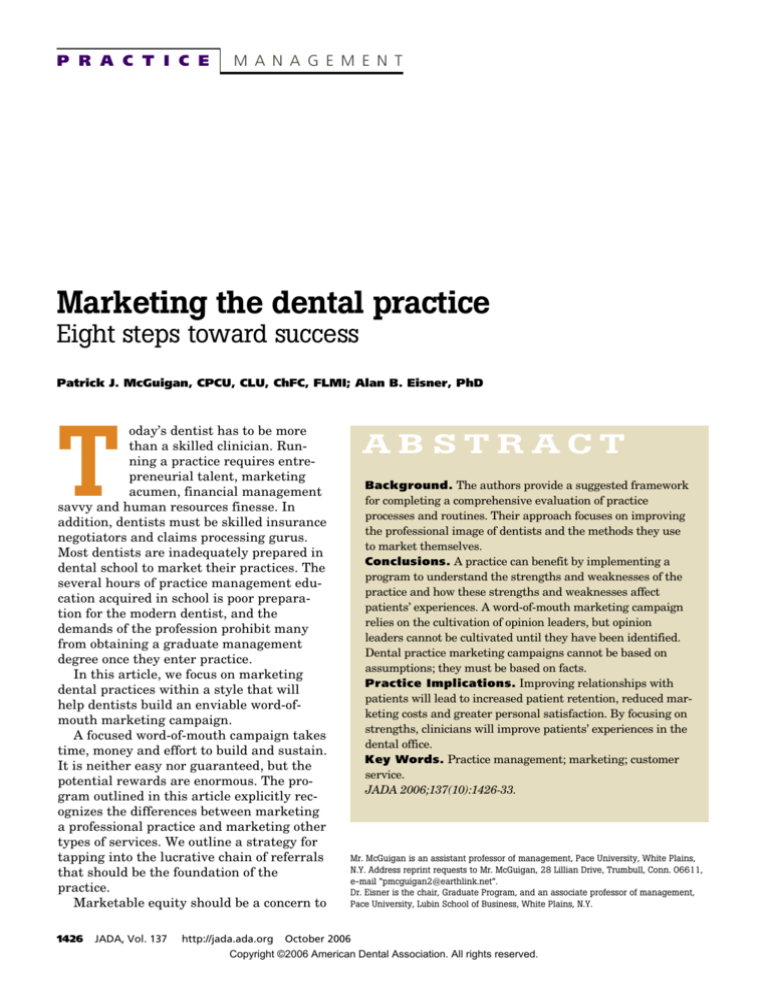
P R A C T I C E
M A N A G E M E N T
Marketing the dental practice
Eight steps toward success
Patrick J. McGuigan, CPCU, CLU, ChFC, FLMI; Alan B. Eisner, PhD
oday’s dentist has to be more
than a skilled clinician. Running a practice requires entrepreneurial talent, marketing
acumen, financial management
savvy and human resources finesse. In
addition, dentists must be skilled insurance
negotiators and claims processing gurus.
Most dentists are inadequately prepared in
dental school to market their practices. The
several hours of practice management education acquired in school is poor preparation for the modern dentist, and the
demands of the profession prohibit many
from obtaining a graduate management
degree once they enter practice.
In this article, we focus on marketing
dental practices within a style that will
help dentists build an enviable word-ofmouth marketing campaign.
A focused word-of-mouth campaign takes
time, money and effort to build and sustain.
It is neither easy nor guaranteed, but the
potential rewards are enormous. The program outlined in this article explicitly recognizes the differences between marketing
a professional practice and marketing other
types of services. We outline a strategy for
tapping into the lucrative chain of referrals
that should be the foundation of the
practice.
Marketable equity should be a concern to
T
1426
JADA, Vol. 137
ABSTRACT
Background. The authors provide a suggested framework
for completing a comprehensive evaluation of practice
processes and routines. Their approach focuses on improving
the professional image of dentists and the methods they use
to market themselves.
Conclusions. A practice can benefit by implementing a
program to understand the strengths and weaknesses of the
practice and how these strengths and weaknesses affect
patients’ experiences. A word-of-mouth marketing campaign
relies on the cultivation of opinion leaders, but opinion
leaders cannot be cultivated until they have been identified.
Dental practice marketing campaigns cannot be based on
assumptions; they must be based on facts.
Practice Implications. Improving relationships with
patients will lead to increased patient retention, reduced marketing costs and greater personal satisfaction. By focusing on
strengths, clinicians will improve patients’ experiences in the
dental office.
Key Words. Practice management; marketing; customer
service.
JADA 2006;137(10):1426-33.
Mr. McGuigan is an assistant professor of management, Pace University, White Plains,
N.Y. Address reprint requests to Mr. McGuigan, 28 Lillian Drive, Trumbull, Conn. 06611,
e-mail “pmcguigan2@earthlink.net”.
Dr. Eisner is the chair, Graduate Program, and an associate professor of management,
Pace University, Lubin School of Business, White Plains, N.Y.
http://jada.ada.org October 2006
Copyright ©2006 American Dental Association. All rights reserved.
P R A C T I C E
M A N A G E M E N T
Practice Vision Process
O
n
g
o
i
g
Vision/Mission
D
e
v
e
l
o
p
m
e
n
t
o
f
Values
Define Key Strategic Goals
Annual Goals–Tactical Methods for
Achieving Strategic Goals
Project–Specific Tactics to Support Annual Goals
V
i
s
i
o
n
R
e
v
i
e
w
P
r
o
c
e
s
s
Results
Figure 1. Practice vision process.
every dentist. As clinicians build their practice,
they should develop a strategy that takes into consideration what it will look like when they sell it.
If they do this, chances are that the business will
be of greater value when the time comes. Most
assets provide a depreciating return on investment
(equipment is a good example). The list of patients,
on the other hand, can offer an escalating return
on investment. How the dentist manages that
list—and consequently the relationships that the
list embodies—will determine the value of the
dental practice in the long run.
At one time, a dentist’s reputation was assumed
to be the major prerequisite for success in dentistry. From the patient’s perspective, reputation
was represented by a prestigious address, suitable
office furnishings and a practice built on word of
mouth. Success now is defined in a variety of ways,
and it is critical for practitioners to look beyond
the traditional concept of reputation and view
their practice as a business. The reality is this: if
the practice fails as a business, the practitioner
fails as a medical professional.1
DEVELOPING A MARKETING PLAN
Professional success in a competitive market may
be contingent on establishing a plan to achieve
that success. Developing a professional services
marketing plan with a focus on word-of-mouth
referrals consists of the following eight steps:
ddetermining practice objectives by working
through a practice vision process (Figure 1);
dconducting a practice management audit and
using a value analysis wheel to determine
processes critical to value;
danalyzing the value creation circle;
dcompleting a practice evaluation and review;
dcreating an advantage proposition based on
value creation and an appraisal;
dconducting a relationship audit to determine
centers of influence and opinion leaders;
ddetermining specific steps required to retain,
expand and promote centers of influence and
opinion leaders;
ddeveloping a list of specific actions and placing
dates on it for them to be accomplished.
Clinicians cannot identify off the tops of their
heads the factors that make a practice successful
or unsuccessful. Flying by the seat of one’s pants is
dangerous and expensive. More important, dentists probably will miss the factors that actually
contribute to or distract from practice success.
PRACTICE VISION PROCESS
For objectives to be meaningful, they must satisfy
several important criteria. The objectives have to
JADA, Vol. 137 http://jada.ada.org
Copyright ©2006 American Dental Association. All rights reserved.
October 2006
1427
P R A C T I C E
M A N A G E M E N T
be measurable (for example, adding 50 new
patients to the practice). There must be at least
one indicator that measures progress against the
attainment of the objective. The objectives must be
specific and convey a clear and concrete message
regarding what needs to be accomplished.2 Many
practitioners set objectives that are ancillary to
their primary purpose, but the objectives must be
appropriate and consistent with the practice vision
process (Figure 1).
Objectives span a range of purposes, but they
must be realistic. Setting unrealistic objectives sets
the practice up for disappointment at best, and
failure at worst. The target (or objective) must be
achievable, given the practice’s capabilities and
opportunities. The target should be challenging
but doable. The clinician must establish a time
frame for accomplishing the objectives. If no dates
are assigned, then the objectives are merely a
wish list.
One benefit of setting objectives is that they
help channel all employees toward a common goal.
This concentrates efforts and conserves valuable
resources so, collectively, all members of the practice can enjoy more success and fulfillment.
Second, challenging objectives motivate and
inspire employees to higher levels of commitment
and effort. Research consistently and overwhelmingly supports the fact that people work harder
when they are striving toward specific goals.3(p109)
Third, setting and communicating goals prevents
interested parties (such as staff members and vendors) from working at cross-purposes. Finally,
objectives provide the measure by which rewards
and incentives should be allocated.
PRACTICE MANAGEMENT AUDIT
An important step in setting the overall objectives
of the practice is to assess the current status of the
practice. Procedures typically are implemented to
solve immediate problems, and, as a result, the
operations of the practice may be hindered by
unintended inefficiency. It is important to measure
the current processes used by the practice against
a known standard (such as a process that has
proven to be effective across many practices) to
assess their operational efficiency. A practice audit
provides an opportunity for practitioners to identify critical deficiencies, such as gaps in service and
communication lapses.
The ideal practice manages the patient experience for maximum satisfaction, aligns the objectives of the owner with those of staff members, cap1428
JADA, Vol. 137
italizes on each marketing opportunity and provides above-average returns to the owner. Often, it
is the simple things (such as saying “thank you”)
that are overlooked during the day-to-day activities, but they frequently enable the practice to
derive the greatest benefit from relationships. It is
important for dental practices to choreograph carefully each step of the patient’s experience, from
first contact through follow-up after discharge. All
staff members who come into contact with patients
should be familiar with the steps in the process,
and practitioners must expect consistency as a
minimum standard.
Establishing trustworthiness. Trust between
the patient and the dental practice is critical.
Trustworthiness is predicated on the following
simple set of criteria that is easy to overlook4:
dcompetence;
dpromptness;
dreliability;
dability to customize solutions;
dpoliteness;
dempathy.
When the factors that build trust are ignored,
the practice suffers. Practitioners should assess
this dimension of the practice as part of the management audit.
The success of the practice depends not only on a
high-quality experience for the patient while he or
she is being treated, but also on each interaction
the patient has with staff members. If a patient is
in the waiting room and observes negative
behavior or overhears negative comments, this has
an unfavorable effect on his or her assessment of
the experience. Staff members do not need to be in
direct contact with the patient to create an impression. They need to understand the consequences of
their actions. Practice management should not be
left to chance; rather, the goals and objectives must
be understood clearly by all of the organizational
stakeholders.
The practice management audit requires an
independent assessment of the practice on an
annual basis. A combination of direct observation,
interviews (with staff members, patients and all
other interested parties) and surveys are used to
assess the flow of work in the practice. The audit
should pay close attention to each contact point
with patients and document how staff members
communicate with them. The audit begins with the
first telephone call to the office and continues
through the final follow-up call. In addition, the
audit examines the processes that are in place to
http://jada.ada.org October 2006
Copyright ©2006 American Dental Association. All rights reserved.
P R A C T I C E
bring the patient back to the practice on a regular
basis. This includes all current advertising and
marketing methods, as well as supervisory
procedures.
Value analysis wheel. To assess the strengths
and weaknesses of the practice, the dentist uses a
value analysis wheel as part of the audit (Figure
2). The patient’s experience, which is the center of
the wheel, can be represented by a series of steps
that have financial, physical, individual and practice resources associated with them. The dentist
and staff members treat the experience as the primary activity of the value chain (that is, a
sequence of steps leading to an outcome from
which the practice derives value), and all other
activities exist only to support the primary
activity. Thus, human resource management,
accounting, purchasing, inventory control and
practice automation are all support activities.
The value analysis wheel helps the dentist and
staff members focus attention on critical tasks, and
it ensures that primary tasks are handled with
excellence.5 The dentist should not allow support
activities to distract from the primary activity,
because the outcome could be a negative experience for the patient.
Finally, the practice audit sets the stage for the
360-degree review and relationship audit (that is,
an evaluation by staff members, patients, vendors
and peers conducted to obtain balanced feedback)
discussed below.6 It does not make sense to try to
expand the practice until its processes are optimal.
Optimal processes. Optimal processes focus
on the patient at each contact point. Consistency of
service is critically important from the patient’s
standpoint. When the dentist and dental team
create an atmosphere that welcomes patients and
demonstrates that they value their business,
patients will reward the practice with referrals.
People love to talk about the experiences that have
brightened their day or are out of the ordinary.
VALUE PROPOSITION
Patients visit the dentist for a variety of reasons,
but we can boil them down to four categories:
hygiene, alleviation of pain, esthetics or replacement (which may result from necessity, esthetics
or both). Dentists can create the most value for
patients by alleviating pain, but it is likely that the
practice is built on hygiene, cosmetic dentistry or
replacement. Dentists need to ask themselves
what type of dentist they are, and what type of
dentist they would like to be in the future. In other
Follow-up
Discharge
Dental
Practice
Demonstrates
Prompt
Interest
M A N A G E M E N T
Initial
Contact
Patient’s
Experience
Schedule
Appointment
Confirm
Appointment
Treatment
Check
In
First Visit
Figure 2. Value analysis wheel.
words, how do dentists create value for patients?
It is important for dentists to know how they
create value and to communicate this to patients,
because the financial dimension of the relationship
frequently is driven by insurance. Dentists cannot
allow third-party reimbursement to drive the value
proposition of their practice, but they also cannot
avoid the reality that insurance creates. Dental
insurance reimbursement levels are low, and thirdparty payers will not cover many of the procedures
that dentists would like to perform for their
patients’ benefit. Understanding how practitioners
create value starts with a firm understanding of
how patients perceive value.
We believe that people perceive value primarily
for one of four reasons, and what drives one person
may not be a motivator for another.
Return on investment. The first type of motivation is return on investment. A person who
values return on investment justifies purchase
decisions on the basis of a logical cost/benefit
analysis. He or she wants to know what the return
on investment will be for a given procedure. For
example, if a patient is considering investing a significant amount of money in a dental implant, he
or she wants to be able to justify the purchase in
terms of return on investment (such as improved
function and esthetics). It is important for the dentist to discuss with the patient the costs of alternative procedures, failure rates of various alternative
JADA, Vol. 137 http://jada.ada.org
Copyright ©2006 American Dental Association. All rights reserved.
October 2006
1429
P R A C T I C E
M A N A G E M E N T
procedures and the nonfinancial rewards of an
or her treatment recommendations? These are the
implant. Such patients need a clear understanding
patients that clinicians want to attract. Interestof each benefit. If they perceive the benefits to
ingly, one of the principles of relationships is that
exceed the costs, they probably will proceed with
similar people tend to flock together. If a dentist
the procedure.
has a number of patients who are driven by a
Time. The second type of motivation is time. In
return on investment, for example, it is likely that
today’s hectic world, many people are pressed for
the people they refer to the practice also are driven
time and saving time is their primary value driver.
by a return on investment.
When treating this type of patient, clinicians must
Clinicians need to begin by understanding
respect the appointment schedule; if deviations are
themselves and what drives value for them. Once
necessary, it is important to explain why. When
they understand their value creation circle, they
talking with such patients about the benefits of a
can gain more insight into the drivers of value for
certain procedure, dentists should explain how this
their patients. Dentists need to communicate with
treatment will save them time
patients in a language they undertoday, as well as in the future (for
stand. If they leave this process to
example, dental implants versus
chance, clinicians risk letting
Dentists need to
removable dental prostheses).
patients walk away because they
combine professional
Time is a valuable commodity
have failed to understand their
skills with interpersonal needs.
that often is overlooked. By
paying greater attention to what
Interpersonal skills. Dental
skills to build a loyal
matters most to patients, cliniservices
are inseparable from the
base of patients.
cians will be more effective.
person delivering them. Not only is
Risk. The third type of motithe patient judging the dentist’s
vation is risk. The perception of
clinical skills, but he or she also is
risk underpins all human decision making. A
judging the dentist’s interpersonal skills.7 Dentists
patient who perceives excessive risk is not likely to
do not have to become marketing mavens or underundergo a procedure. Loading up patients with
stand the nuances of a well-placed advertisement,
brochures, facts and charts may elevate their
but they need to combine professional skills with
anxiety, not alleviate it. By waging an informainterpersonal skills to build a loyal base of patients
tion campaign in this way, dentists may be valiwho will refer others to the practice. Dentists may
dating patients’ misguided perceptions of the risk
be their own worst enemies if they fail to demoninvolved. Rather, dentists should take the time to
strate to their patients how competent they are—
that is, if they fail to explain their value
talk with patients about proposed treatment
proposition.
plans. They should tell patients about the
number of similar procedures they have perPRACTICE EVALUATION AND REVIEW
formed successfully and let them know that
A U.S. Air Force captain in the 1950s said, “If
many patients have had the same concerns. Manthings can go wrong, they will.” This is known
aging risk perceptions often is counterintuitive.
more famously as “Murphy’s law.” In an increasBrand/image. The final type of motivator is
ingly complex world with more competition, more
brand/ image. For patients who are motivated by
demanding consumers and relationships strained
brand / image, it is important for dentists to
by a lack of time, it is critical for dentists to assess
explain their credentials and how significant
their performance with regard to relationships.
they are. They need to tell patients about the
The first step in evaluating one’s performance is to
products they will use and why they selected
conduct a formal review.
them from among others. In addition, it is imporOverconfidence bias. Most experts do not
tant for clinicians to focus on how the procedure
believe that people are capable of forming realistic
will enhance the patient’s well-being and
assessments of their own performance and capabilimprove his or her self-image.
ities.3(pp202-4) The overconfidence bias is so pervasive
The value proposition should be determined by
that it influences almost all human thought and
that which creates value for patients. What type of
action.8 This bias is a tendency to attribute success
patient is most closely aligned with the dentist’s
to internal factors and failure to external factors.8
style and personality? What type of patient shares
The bottom line is that we may not be the best
the dentist’s values and is most likely to accept his
1430
JADA, Vol. 137
http://jada.ada.org October 2006
Copyright ©2006 American Dental Association. All rights reserved.
P R A C T I C E
judges of our own performance.
Appraisal process. To obtain a realistic judgment of his or her own performance, the dentist
needs to conduct a practice evaluation and review
periodically. During the appraisal process, associates, trusted peers, dental and medical professionals in the referral network, vendors, select
patients, staff members (who provide anonymous
feedback), partners and the office manager are
asked to appraise the dentist’s performance on a
range of topics, including interpersonal skills,
motivation, professionalism, business acumen,
attitude, aptitude and practice management skills.
The appraisal process is repeated for each partner,
associate and staff member. (Editor’s note: The
practice evaluation and review is one approach to
potentially improving the operations of the dental
office. This article does not constitute legal advice,
and this approach should be considered in consultation with a personal attorney.)
In effect, the dentist is giving himself or herself
and those connected with the practice a periodic
checkup. The opinions of people who care about the
practice and the performance of the dentist and
dental team can be of most value. This is a difficult
process to undergo, however, because people may
learn things about themselves that they would
have preferred not knowing.
Emphasize strengths. Appraisals usually are
intent on finding areas of weakness, but this
process is designed to uncover strengths as well.
Dentists should delegate tasks that they do not
perform well (for example, process third-party
reimbursement) and focus their energy in the
areas in which they excel. By discovering and
exploiting his or her strengths, the clinician will
build a stronger practice and better relationships,
as well as experience greater personal satisfaction.
More importantly, with this knowledge, the dentist
will be better able to align his or her objectives
with reality.9 The opinions of others matter, and if
dentists have the courage to undergo this process,
they can learn a lot about themselves and how to
manage their practices most effectively.
ADVANTAGE PROPOSITION
Why should a patient come to a dentist’s practice
or refer a friend? The perceived risk in going to the
dentist is high for the patient. Compounding the
perceived risk is the probability that the patient
lacks the information to make an informed choice.
Evaluating alternatives for dental treatment and
deciding where to purchase dental services is a
M A N A G E M E N T
complex process. Dental care usually is sought
infrequently, and most patients do not have much
direct experience choosing dentists. Compounding
an already difficult problem is the possibility that
the patient is unable to define his or her problem
sufficiently. He or she lacks the confidence to make
an informed choice, and the complexity of the
choice is aggravated by his or her limited understanding of the various alternative treatments.
Limited experience with purchasing dental services implies that the patient has not developed a
set of evaluative criteria (that is, a set of heuristics
that facilitates choice) that can be recalled easily
from memory. With most services, the service
provider quickly sets about developing a strategy
to teach consumers which evaluative criteria are
appropriate. The criteria are based on what the
service provider believes will provide him or her
with an advantage.4 Most service providers are
adept at making the evaluation process easy for
potential buyers. When the lawn mower stops
working, for example, the consumer has little
trouble identifying the problem, selecting a service
technician and applying a set of criteria to evaluate
each alternative. However, when a patient seeks
dental treatment, he or she may not know which
dentist to call.
To help the patient make an informed choice,
the dentist should develop an advantage proposition. This is a written statement of what the dentist and the practice stand for. (It should be posted
on the practice’s Web site and included in any
other communication vehicles.) The statement
transforms the dentist’s beliefs and values into
action, but it also establishes accountability. The
dentist must be prepared to stand behind the
proposition every time a patient interacts with
someone in the practice. Dentists must demonstrate that the things to which they have committed themselves have been done and
done well.
RELATIONSHIP AUDIT
All relationships exist on a continuum. In a
service business such as dentistry, practitioners
cannot leave relationships to chance. A dentist’s
primary asset is his or her list of patients, and
the value of the asset is not the revenue it generates, but the strength of the relationships that
underlie that revenue. Relationships are one of
only a few assets that do not depreciate with use;
in fact, they can increase in value if properly
cared for. However, dentists must validate
JADA, Vol. 137 http://jada.ada.org
Copyright ©2006 American Dental Association. All rights reserved.
October 2006
1431
P R A C T I C E
M A N A G E M E N T
empirically the strength of their relationships.
A relationship audit is a thorough evaluation
of relationships with patients. The dental practice mails each patient a survey, and, if needed,
follows up by telephone to assess the quality of
the relationships. It is important to solicit feedback regarding the performance of the dentist
and staff members, hospitality, professionalism
and overall level of satisfaction.
Center of influence. A practitioner must
know who is a center of influence in the community.10 A center of influence, or an opinion leader,
is someone whom people seek out for advice and
counsel.
A single opinion leader can refer hundreds of
patients to a dental practice, but these relationships must be tended carefully. An opinion leader
does not assume this role by accident. He or she
aspires to fill this role. An opinion leader builds a
broad network and strengthens that network by
facilitating trade among the members. A dentist
may have opinion leaders in his or her practice,
although they may not have been identified.
Meticulous record keeping is required to understand where your patients are coming from and
why they stay with the practice.
Solicit feedback. For example, a patient for
whom the dentist has performed a significant
amount of work volunteered that she was leaving
the practice. She explained that she didn’t really
know why she wasn’t going back; she was happy
with the work but did not feel that it was in her
best interest to stay with the practice. She did
not even know where she was going or how she
would make the choice. Why did she leave?
This—an apparently good patient’s leaving the
practice for no explicable cause—is the reason to
conduct a relationship audit. A relationship audit
would have provided this patient with the opportunity to explore her feelings and convey them to
the dental practice.
It is easy to dismiss this example as an
anomaly, but that is a simplistic response to a
complex problem. The relationship audit is predicated on networking principles. The dentist
needs to personalize the relationship between the
patient and the practice for it to be meaningful
and satisfying. Patients want to feel that they
are part of the practice. In addition, people tend
to do what is expected of them.9 If the dentist
does not lay out his or her expectations with
regard to being a part of the practice, how will
patients know how to behave?
1432
JADA, Vol. 137
If relationships are left to chance, it is likely
that practitioners will have a transaction-based
practice, not a relationship-based practice. It is
critically important for clinicians to reach out to
patients as often as possible. Repeated interaction encourages cooperation. Finally, dentists
should keep in mind that the world is small and
it is important to network continually.
The process of building and maintaining
strong relationships will not work for the insincere. Patients will read through a dentist’s
motives if he or she engages in these efforts only
to increase revenue. Making relationships an
explicit priority means that dentists must genuinely care about their patients and their
welfare.
CULTIVATING OPINION LEADERS
Once dentists have completed the first six steps
discussed above, they will know which objectives
they would like to achieve, what they value, how
well their practice runs, the quality of their relationships and their advantage proposition. It is
important to take this information and cultivate
opinion leaders in the marketplace. Where does
one find them? In truth, they are all around.
Other opinion leaders are the only people who
will actively help you find them. They are always
looking to expand their networks, and they look
for people who are proactive about networking
and know where they are going and why they
want to get there. The eight steps toward success
help practitioners become that type of person.
Activity generates activity; this is an undeniable
truth known to every salesperson. Opinion
leaders are not hiding from dentists, but it is key
that they know you are committed to excellence
and building quality relationships.
It is important for practitioners to develop a
visible presence in the community. This is accomplished by joining groups composed of leaders in
other professions, civic groups and committees
important to community development. There is a
chronic shortage of qualified people who volunteer to fill important roles in the community.
Practitioners need to get involved; it will bring
personal satisfaction and often referrals.
If there are organizations in the community
that employ a large number of people, including
the local government and school system, the dentist should strive to create relationships with
them. These employers need to know about the
practice’s advantage proposition and how the
http://jada.ada.org October 2006
Copyright ©2006 American Dental Association. All rights reserved.
P R A C T I C E
dentist has helped people in the community.
TIMETABLE OF ACTIONS
Dentists need to establish dates for achieving their
objectives and create a timetable by which each
phase of the project (such as the practice management audit) will be completed. The practice is
where it is because of the choices the dentist has
made, and it is time to make choices that will benefit him or her explicitly, as well as the practice’s
patients, the dental team, the dentist’s family and
the community.11
CONCLUSION
It is beyond the scope of this article to explore in
depth the benefits, on many levels, of improving
relationships. It can be the single most rewarding
aspect of a dentist’s career. Discovering one’s
strengths and those of staff members, and then
working toward one’s strengths and delegating
tasks to those whose skills complement one’s own
is a rewarding experience. As Patton said, “Accept
M A N A G E M E N T
the challenges so that you might know the exhilaration of victory.”12 ■
1. Lovelock CH. Classifying services to gain strategic marketing
insights. J Marketing 1983;47(3):9-20.
2. Wilson A. The marketing of professional services. New York City:
McGraw-Hill; 1972.
3. Block P. The empowered manager. San Franciso: Jossey-Bass;
1987:109, 202-4.
4. Warrington TB, Abgrab NJ, Caldwell HM. Building trust to develop
competitive advantage in e-business relationships. Competitiveness Rev
Summer-Fall 2000:46-67.
5. Uhl KP, Upah GD. The marketing of services: why and how is it different? Res Marketing 1983;6:231-57.
6. Urban GL, Sultan F, Qualls WJ. Placing trust at the center of your
Internet strategy. MIT Sloan Management Rev 2000;42(1):39-48.
7. Bloom PN. Effective marketing for professional services. Harvard
Business Rev Sept-Oct 1984:102-10.
8. Kahneman D, Tversky A. Choices, values, and frames. New York
City: Wiley; 2000:184-224.
9. DeWulf K, Odekerken-Schroder G, Lacobucci D. Investments in consumer relationships: a cross-country and cross-industry exploration. J
Marketing 2001;65(4):33-50.
10. Kotler P, Bloom PN. Marketing professional services. Englewood
Cliffs, N.J.: Prentice Hall; 1984:84-5.
11. Knights D, Noble F, Vurdubakis T, Willmott H. Chasing shadows:
control, virtuality and the production of trust. Org Studies
2001;22(2):198-212.
12. Axelrod A. Patton on leadership. Englewood Cliffs, N.J.: Prentice
Hall; 1994:219.
JADA, Vol. 137 http://jada.ada.org
Copyright ©2006 American Dental Association. All rights reserved.
October 2006
1433

